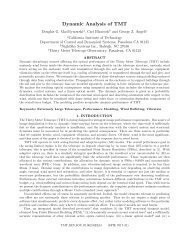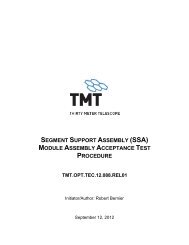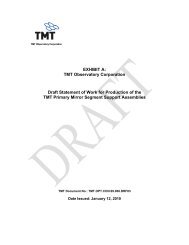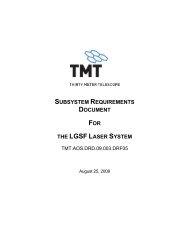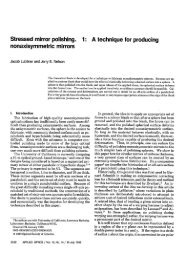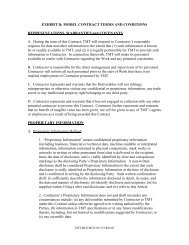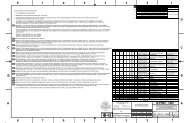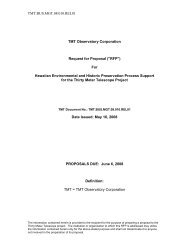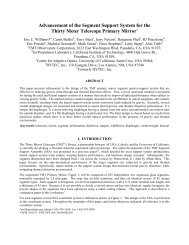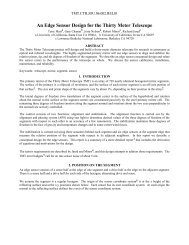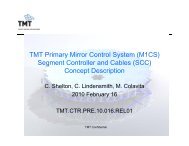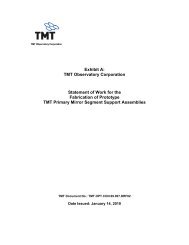Exhibit B: Specification for M2 Segment Blank - Thirty Meter Telescope
Exhibit B: Specification for M2 Segment Blank - Thirty Meter Telescope
Exhibit B: Specification for M2 Segment Blank - Thirty Meter Telescope
You also want an ePaper? Increase the reach of your titles
YUMPU automatically turns print PDFs into web optimized ePapers that Google loves.
TMT.OPT.SPE.07.005.REL01 Page 18 of 20<br />
SECONDARY MIRROR BLANK SPECIFICATIONS 1/12/2010<br />
Figure 4. ΔL/L and Instantaneous CTE measurement data of a hypothetical CTE Specimen “n”<br />
7.3 CALCULATING SHOP-OP EFFECTIVE CTE AND OPERATING RANGE AVERAGE CTE<br />
7.3.1 Shop-Op Effective CTE<br />
The requirements in Section 3.1.5.4 require calculation of the Shop-Op Effective CTE of each CTE<br />
Specimen over the Shop-Op Temperature Range from 2°C to 20°C. Figure 5 graphically illustrates<br />
the calculation of the Shop-OpEffective CTE <strong>for</strong> each CTE Specimen <strong>for</strong> the <strong>M2</strong> <strong>Blank</strong>.<br />
The Shop-Op Effective CTE of the <strong>M2</strong> <strong>Blank</strong> shall be the average of the Shop-Op Effective CTEs of<br />
all the CTE Specimens.<br />
7.3.2 Operating Range Average CTE<br />
The requirements in Section 3.1.5.5 require calculation of the Operating Range Average CTE of each<br />
CTE Specimen using the Instantaneous CTE measurements of the CTE Specimen. For the<br />
purposes of this specification, Operating Range Average CTEs shall be calculated using<br />
Instantaneous CTE values at the Observatory Temperatures: -5°C, 2°C and 9°C. This is graphically<br />
illustrated in Figure 5 <strong>for</strong> one CTE Specimen.<br />
The <strong>M2</strong> <strong>Blank</strong> Operating Range Average CTE is calculated by averaging the calculated Operating<br />
Range Average CTE values from all the CTE Specimens (calculated only at the Observatory<br />
Temperatures: -5°C, 2°C and 9°C). This is done by summing the CTE Specimen Operating Range<br />
Average CTEs then dividing the sum by the number of CTE Specimens. For the sampling example in<br />
Figure 3, one would use the CTE Specimens in layer 1 and the CTE Specimens in layer 3 to calculate<br />
the Average CTE of the <strong>M2</strong> <strong>Blank</strong>.



